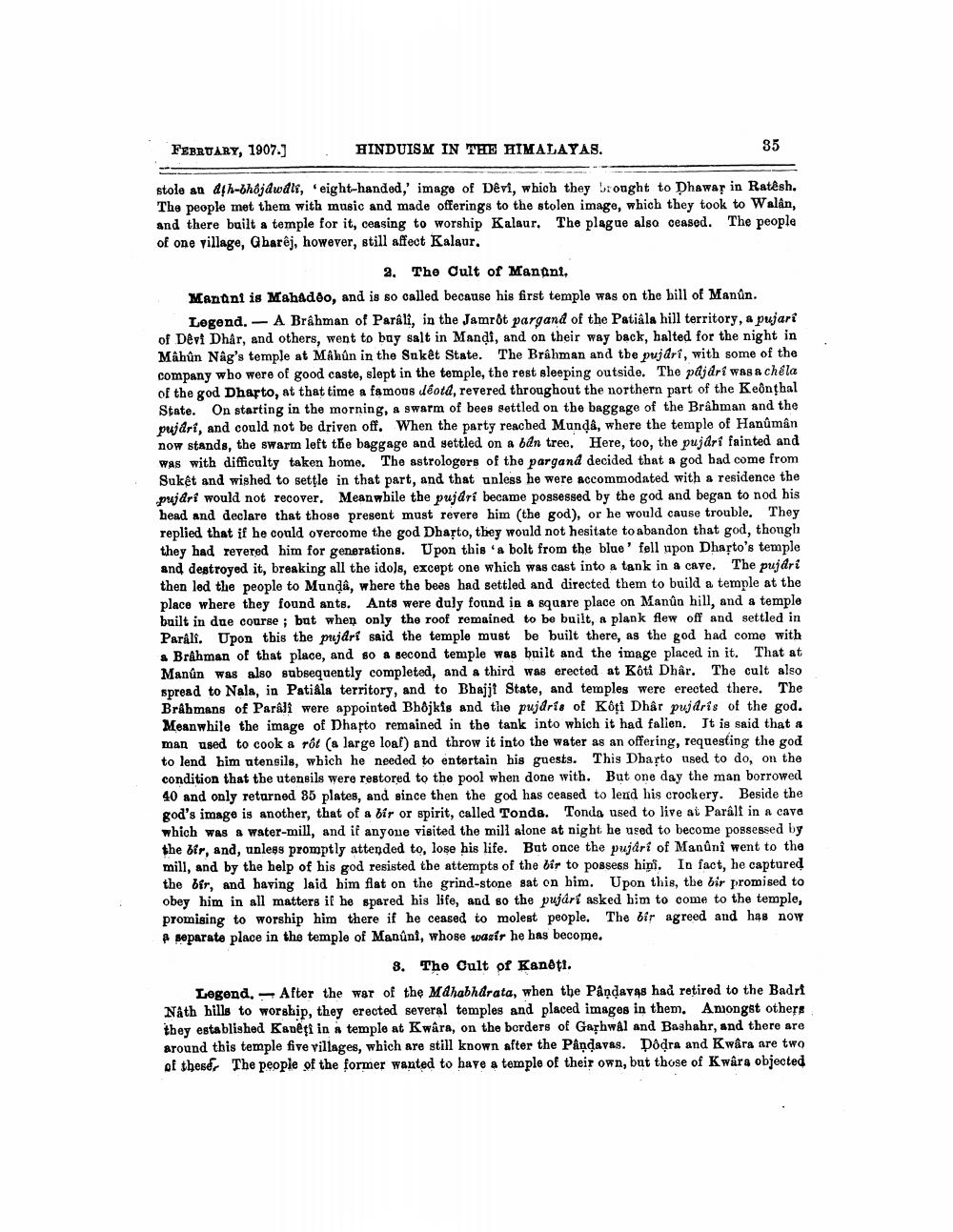________________
FEBRUARY, 1907.)
HINDUISM IN THE HIMALAYAS.
35
stole an dih-bhojdwdle, eight-handed,' image of Devi, which they bronght to Dhawar in Ratêsh, The people met them with music and made offerings to the stolen image, which they took to Walân, and there built a temple for it, ceasing to worship Kalaur. The plague also ceased. The people of one village, Gbarêj, however, still affect Kalaur.
2. The Cult of Manani, Mantni is Mahadeo, and is so called because his first temple was on the bill of Manûn.
Legend. - A Brahman of Parali, in the Jamrôt pargand of the Patiala hill territory, a pujari of Devi Dhår, and others, went to buy salt in Mandi, and on their way back, halted for the night in Mahûn Nag's temple at MAhún in the Suket State. The Brahman and the pujari, with some of the company who were of good caste, slept in the temple, the rest sleeping outside. The pajari was a chéla of the god Dhafto, at that time a famous déota, revered throughout the northern part of the Keônthal State. On starting in the morning, a swarm of bees settled on the baggage of the Brâhman and the pujari, and could not be driven off. When the party reached Munda, where the temple of Hanûmân now stands, the swarm left the baggage and settled on a ben tree. Here, too, the pujdri fainted and was with difficulty taken home. The astrologers of the pargand decided that a god bad come from Suket and wished to settle in that part, and that unless he were accommodated with a residence the pujari would not recover. Meanwhile the pujdrí became possessed by the god and began to nod his head and declare that those present must revere him (the god), or he would cause trouble. They replied that if he could overcome the god Dharto, they would not hesitate to abandon that god, though they had revered him for generations. Upon this 'a bolt from the blue' fell upon Dharto's temple and destroyed it, breaking all the idols, except one which was cast into a tank in a cave. The pujdri then led the people to Munda, where the bees had settled and directed them to build a temple at the place where they found ants. Ants were duly found in a square place on Manûn hill, and a temple built in due course ; but when only the roof remained to be built, a plank flew off and settled in Paráli. Upon this the pujdri said the temple must be built there, as the god had come with a Brahman of that place, and so a second temple was built and the image placed in it. That at Manûn was also subsequently completed, and a third was erected at Koti Dhår. The cult also spread to Nala, in Patiala territory, and to Bhajjt State, and temples were erected there. The Brâhmans of Parali were appointed Bhojkis and the pujdris of Kôți Dhâr pujdris of the god. Meanwhile the image of Dhafto remained in the tank into which it had fallen. It is said that a man used to cook a rôt (a large loal) and throw it into the water as an offering, requesting the god to lend him utensils, which he needed to entertain his guests. This Dbasto tised to do, on the condition that the utensils were restored to the pool when done with. But one day the man borrowed 40 and only returned 85 plates, and since then the god has ceased to lend his crockery. Beside the god's image is another, that of a bir or spirit, called Tonds. Tonda used to live at Paralf in a cava which was a water-mill, and if anyone visited the mill alone at night he used to become possessed by the bir, and, unless promptly attended to, lose his life. But once the pujari of Manûnî went to the mill, and by the help of his god resisted the attempts of the bir to possess hipi. In fact, he captured the bir, and having laid him flat on the grind-stone sat on bim. Upon this, the bir promised to obey him in all matters if he spared his life, and so the pujdri asked him to come to the temple, promising to worship him there if he ceased to molest people. The bir agreed and has now A separate place in the temple of Manûni, whose waxír he has become.
8. The Cult of Kanoti. Legend. After the war of the Mahabharata, when the Pandavas had retired to the Badet Nath hills to worship, they erected several temples and placed images in them. Amongst others they established Kanêţi in a temple at Kwara, on the borders of Gaphwal and Bashahr, and there are around this temple five villages, which are still known after the Påndavas. Dodra and Kwâra are two of theser The people of the former wanted to have a temple of their own, but those of Kwâra objected




